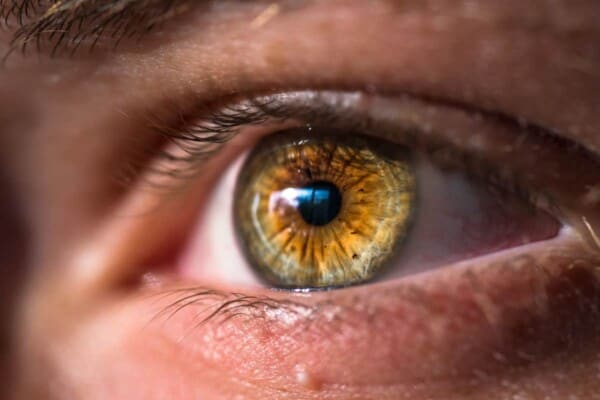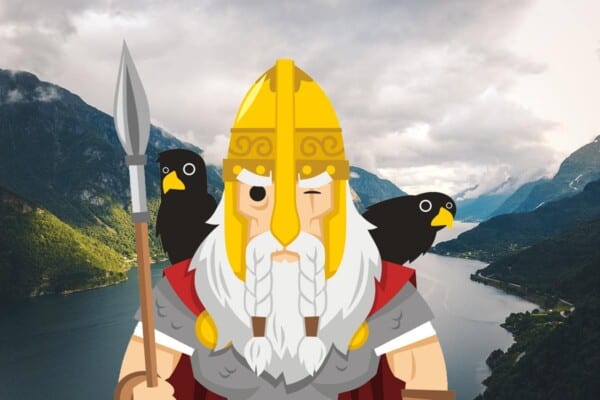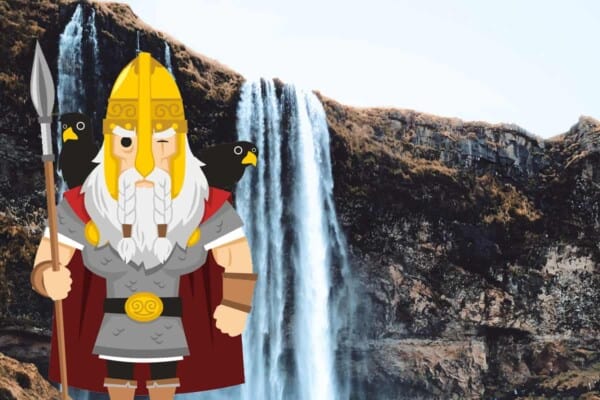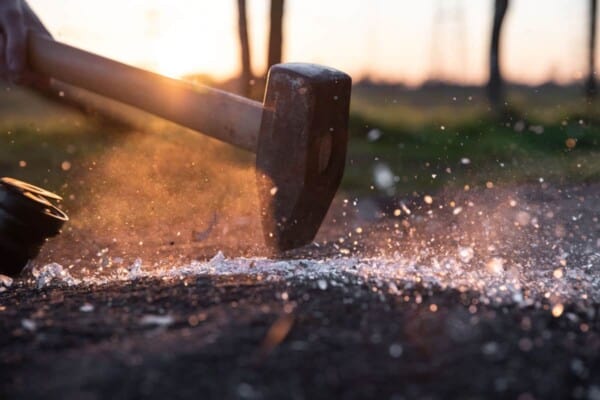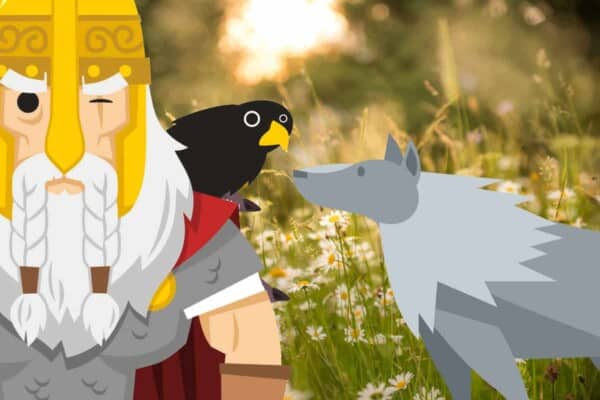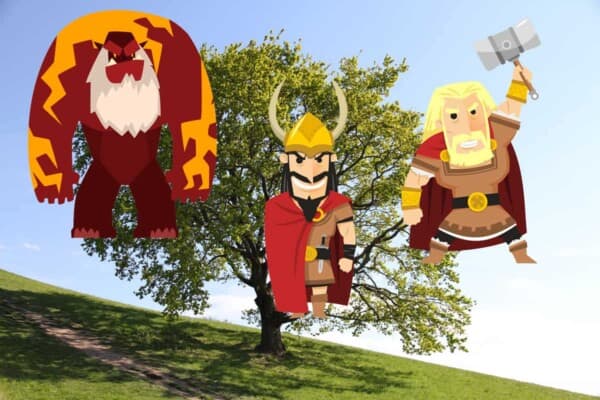Norse mythology is made up of much more than just the famous gods of Odin, Thor and Loki. There are many other gods, monster and creatures that inhabit the 9 worlds.
Of the different creatures we detail below, I think the most interesting have to be the Jötnar, the feared and worthy enemies of the gods. But there are so many more to dive in and take a look at.
So, let’s begin!
Aesir Gods – Those Who Maintain Order Over Chaos
The Aesir gods were a race of warrior gods appearing after the Vanir gods came into existence. They inhabited Asgard which was located at the very top of the tree, Yggdrasil. The most well-known of the gods, Odin and Thor belonged to the Aesir, as well as many other members who each played important roles in Norse mythology.
It is also believed the Aesir’s true purpose on earth was to keep the cosmos from falling apart. They did this by preventing the giants from turning everything back into the chaos from which it was created. The Aesir managed to keep the world from destruction until Ragnarok, at which time they were defeated by the giants and a new world was created.
Almost every Norse myth has one or more Aesir gods playing pivotal roles. This begins from the creation of the Nine Worlds and ends with the myth of Ragnarok. Each god has his or her own purpose, strength, and weakness. Odin is capable of seeing and knowing everything, while Thor’s hammer is the weapon that keeps the giants at bay. Heimdall guards the Rainbow Bridge, while Loki causes insurmountable troubles for each and every god and goddess.
Vanir Gods – Former Enemies of the Aesir
The Vanir gods were a race of gods that inhabited the realm of Vanaheim. They were known to be the original gods and were in existence before the Aesir gods. They were also known to be gods of fertility. Their most notable members were Frey and Freya, both of which end up becoming honoured members of the Aesir.
The Vanir were responsible for bringing peace and bounty to Asgard. They also knew a special form of witchcraft and magic that would eventually be taught to and adopted by the Aesir.
The biggest myth in which the Vanir play an important role is that of the Aesir and Vanir war. When the two tribes of gods fight, the only way they can end the war is to reach an agreement. They end up making peace by exchanging gods. This leads to Frey, Freya, and Njord becoming honorary members. The outcome of the war also eventually leads to all Vanir gods being referred to as Aesir.
Elves – Dark and Light Magical Beings
Elves were believed to be both beautiful and magical beings . The Light Elves lived at the very top of Ygdrassil, while the Dark Elves inhabited Svartelfheim, deep below the earth.
Some writings believe the Dark Elves were actually dwarves, but this is never something which is said outright. Sacrifices were offered to elves in a special ceremony called Alfablot at the beginning of winter. The elves were also known to have somewhat of an ambivalent relationship with humans.
They were often thought of as the ones who caused illnesses and would only offer to heal if a sacrifice was made. It was also believed humans and elves could breed, resulting in half-elf, half-human beings. These beings looked like humans but would have magical and intuitive powers.
Elves are briefly mentioned in Norse mythology and are generally associated with the Aesir. They never play active roles in the myths.
Jötnar or Giants – The Bringers of Chaos and Ragnarok
The giants were known to be enemies of the gods, in particular the Aesir. They were also known to be a race to which some of the gods can trace their lineage to. Odin, Vili, and Ve are known to be the offspring of the giantess Bestla.
But, while there is a shared ancestry between the giants and the gods, the giants tend to represent chaos and nature’s wild forces. They are a race that lives in the mountains and loves being in the dark.
The giants play varying roles in many myths. Sometimes it seems as if they are gods themselves, and other times it seems like they are the enemy. There are myths where giants share drink with the Aesir, and there are times when the giants are ruthlessly killed, often by Thor. It is dependent upon the story and the situation the giant(s) is in.
The biggest role a giant has played in Norse mythology was during the creation of the Nine Worlds. With the body of the giant Ymir, the sky, the earth, the sun, and the moon were all created from his body.
Dwarfs – The Master Craftsman
Dwarves were known to be a race of ugly, short little creatures. They came into existence from the grubs eating off Ymir’s dead corpse. At the time of creation, the gods put them in charge of underground treasures like precious metals and gems.
They were also given the realm of Svartalfheim to call their home. The dwarves were best known for being master crafters. They were also thought to be extremely wise, knowledgeable, and could wield magic.
The major roles the dwarves play in Norse myths is that of treasure makers. They were often visited by the gods and goddesses to make jewellery and unique items that only they could create. They were the ones who were responsible for making Thor’s hammer, as well as a series of other items like Frey’s ship and Odin’s spear.
They also played a pivotal role in the creation of Freya’s beautiful necklace, to which she spent a night with three different dwarves in order to pay for it. The dwarfs also play a role in the death of Kvasir, where they mix his blood with honey to create poetic mead.
Valkyries – The Shield Bearers
The Valkyries were known as Odin’s warrior maidens. They were responsible for choosing which men would die in battle and then taking their souls to Valhalla. They are sometimes referred to as shield-bearers, mists, and spear bearers.
The Valkyries were likely children of the gods and goddesses and could at times, take the form of white swans.
The significance of the Valkyries is the men they would take to Valhalla would be the ones waiting for Ragnarok to come so they could fight at the side of Odin.
They aren’t mentioned in many myths, but they were well-known entities amongst the Germanic people. There are also times when Freya was identified as a leader of the Valkyries. However, it was thought she would take the men to her own hall instead of sending them to Valhalla.
Draugrs – Almost Zombies
Draugrs were known as undead creatures, sometimes referred to as dead men or ghosts. They were thought to live in their graves where they would guard buried treasure, protecting it with their former physical abilities.
The most famous Draugr is considered to be Glamr. He passes away on Christmas Eve but is reanimated.
Jörmungandr – The Nemesis of Thor
Jormungandr was one of Loki’s treacherous children he had with the giantess Angrboda. It was a giant serpent that Odin threw into the Midgard sea. It was often referred to as the Midgard Serpent and was known to be so large that it encircled all of the earth and had its own tail in its mouth. It was the brother to both the wolf Fenrir and the half-human creature, Hel.
The most significant myth involving Jormungandr is Ragnarok. The Midgard Serpent and Thor fight one another. While Thor ends up killing it, the venom that sprayed him ends up poisoning him, leading to his death. Thor and Jormungandr had been enemies throughout their lives, so it was only fitting that they end up being each other’s killers as well.
Fenrir – The Bane of Odin
Fenrir was one of Loki’s treacherous children he had with the giantess Angrboda. He was a wolf that grew so large his jaws reached from earth to the heavens. He was the brother to the serpent Jormungandr and the half-human creature, Hel.
While he originally was taken to Asgard and raised, he was eventually bound and left that way until Ragnarok by Odin and the other gods. They were very fearful of him and his incredible size. He never seemed to stop growing.
The most important myth Fenrir is involved in is Ragnarok. It is there that he kills Odin. This was seen in a prophecy and shows that fate can’t be escaped. The binding of Fenrir is also another important myth. It is where the god Tyr loses his hand, and it is likely why Fenrir wanted revenge on Odin in the first place.
Sleipnir – The Trusty Steed
Sleipnir was an eight-legged horse that was a result of Loki shape-shifting into a mare and mating with the stead Svadilfari in order to distract Svadilfari from helping the Giant Master complete the wall around Asgard on time.
He was a special horse that could gallop over the sea, through air, and run faster than any horse on land. He was also capable of traveling to the world of the dead and would often take both Odin and Hermod there.
He was also known to be a gift from Loki to Odin. Sleipnir appears in various myths. His most important role was carrying Odin into the battle at Ragnarok. He was also the horse Thor rode when he was pitted against the giant Hrungnir and his Golden Mare.
Huginn and Muninn – The Eyes and Ears of Odin
Huginn and Muninn were Odin’s ravens. Huginn was known as Thought and Muninn was known as Memory. Every morning, Odin would send the ravens out to fly around the Nine Worlds. When they returned, they would perch upon Hlidskjalf let Odin in on everything they had seen.
They were considered to be helping spirits and Odin was sometimes referred to as the raven-god. The connection between Odin and the ravens is likely to do with death in battle. When someone was killed during a fight, they were considered to be a gift to the ravens.
The dead men were also considered gifts to Odin, as their spirits would be picked up by the Valkyries and taken to Valhalla. Ravens were also identified with mysticism. Odin being both a shaman and sorcerer makes sense.
The significance Huginn and Muninn would have in myths is being the eyes and ears of Odin. While Odin could see everything from Hlidskjalf, it would always help to have more than just himself watching the comings and goings of those who inhabited the Nine Worlds.
Fossegrims – Musical Water Trolls
Fossegrims were considered to be a water spirit or troll. They were known to play the fiddle and would teach the skills to those who convinced them they were worthy or to those who had food.
The appearance of a Fossegrim was that of a good looking young man. In myths, a Fossegrim was most associated with luring women and children into lakes so they would drown. There are some myths that represent them in a more charming way, with music gathering men, women, and children around them.
Ratatoskrs – Messengers to the Gods
Rotatoskrs were mischievous squirrels that played amongst the branches of Yggdrasil. Sometimes they were messengers to the gods and would carry messages throughout Yggdrasil.
They generally appear as red squirrels and can be known to have rather long ears. Much like the trickster Loki, Rotatoskrs feed off of trouble. They like stirring things up in relationships and are quite entertained by the general outcomes.
In myths, Rotatoskrs can sometimes be represented as a magical drill that Odin would use to drill a hole in a mountain and climb in as a serpent. It was there that he would drink mead filled with wisdom. There is also a possible connection between a Rotatoskr and the god Heimdall, as both were known for their keen eyesight and hearing.
Norns – The Fates of Norse Mythology
The Norns consisted of Fate, Being, and Necessity. They lived by the well of Urd and were thought to shape the life of each being from its first day unto its last.
The Norns were considered to be amongst the most powerful entities within the Nine Worlds which could make them considerably dangerous, as they could both create and control fate.
The Norns appear in the myth The Lay of Grimnir. Odin tells the giant Geirrod that the Norns will only offer him death. They also are briefly mentioned in Loki’s Children and the Binding of Fenrir, as being prophetic and foreseeing the future outcome between Fenrir and Odin.
Mimir – The Wisest of Wise
Mimir was known to be either one of the wisest gods or giants. He is often portrayed as being a counsellor figure to the gods. He was given as a hostage to the Vanir during the Aesir and Vanir war which led to his eventual death. Odin then took his head and brought it back to life, placing it by the well of Urd.
Mimir appears in quite a few myths as a source of knowledge and wisdom for Odin. Odin would consult Mimir’s head quite frequently. His consultation during Ragnarok resulted in him knowing the fate of what was to come for him and his fellow gods.
There isn’t much known about Mimir other than he may be the link that kept the ancestral tradition alive and well.
Einherjar – The Infantry for the Final Battle
The Einherjar were humans who would die in battle and would then be carried to Valhalla by the Valkyries. They would live in Valhalla, preparing and waiting until the time of Ragnarok where they would fight by Odin’s side.
The Einherjar appear briefly in myths. Some older sources say they are served by the Valkeryies in Valhalla where they eat the meat from the boar, Saehrimnir.
The creation of the Einherjar could be loosely based on a Norse cult that was known to worship Odin. They do appear in Ragnarok as fighting by Odin’s side during his battle with Fenrir.
Kvasir – Another Wise Old Man
Kvasir was known to be a wise man that came from the spit of both the Aesir and Vanir gods after the war. He would wander around the world sharing his wisdom. Kvasir was eventually killed by two dwarfs who then use his blood mixed with honey to create the mead of poetry.
In myths, it appears Kvasir may have been a god. It is rather contradictory and isn’t made very clear throughout Norse mythology as to if he is a god or merely a wandering man. In either case, he was known to be full of wisdom and was happy to share it with those who were interested. The myth in which he plays the biggest part in is the one associated with his death and the creation of mead.
Final Thoughts
So that’s all the creatures and monsters from Norse mythology that we felt able to fit into one article. There are of course going to be a few more and this is by no means an exhaustive list.
If you feel we have missed anything or anyone out, then feel free to comment below. Thank!
Contents
- Aesir Gods – Those Who Maintain Order Over Chaos
- Vanir Gods – Former Enemies of the Aesir
- Elves – Dark and Light Magical Beings
- Jötnar or Giants – The Bringers of Chaos and Ragnarok
- Dwarfs – The Master Craftsman
- Valkyries – The Shield Bearers
- Draugrs – Almost Zombies
- Jörmungandr – The Nemesis of Thor
- Fenrir – The Bane of Odin
- Sleipnir – The Trusty Steed
- Huginn and Muninn – The Eyes and Ears of Odin
- Fossegrims – Musical Water Trolls
- Ratatoskrs – Messengers to the Gods
- Norns – The Fates of Norse Mythology
- Mimir – The Wisest of Wise
- Einherjar – The Infantry for the Final Battle
- Kvasir – Another Wise Old Man
- Final Thoughts



